PONTIAC FIERO 1988 Service Repair Manual
Manufacturer: PONTIAC, Model Year: 1988, Model line: FIERO, Model: PONTIAC FIERO 1988Pages: 1825, PDF Size: 99.44 MB
Page 901 of 1825
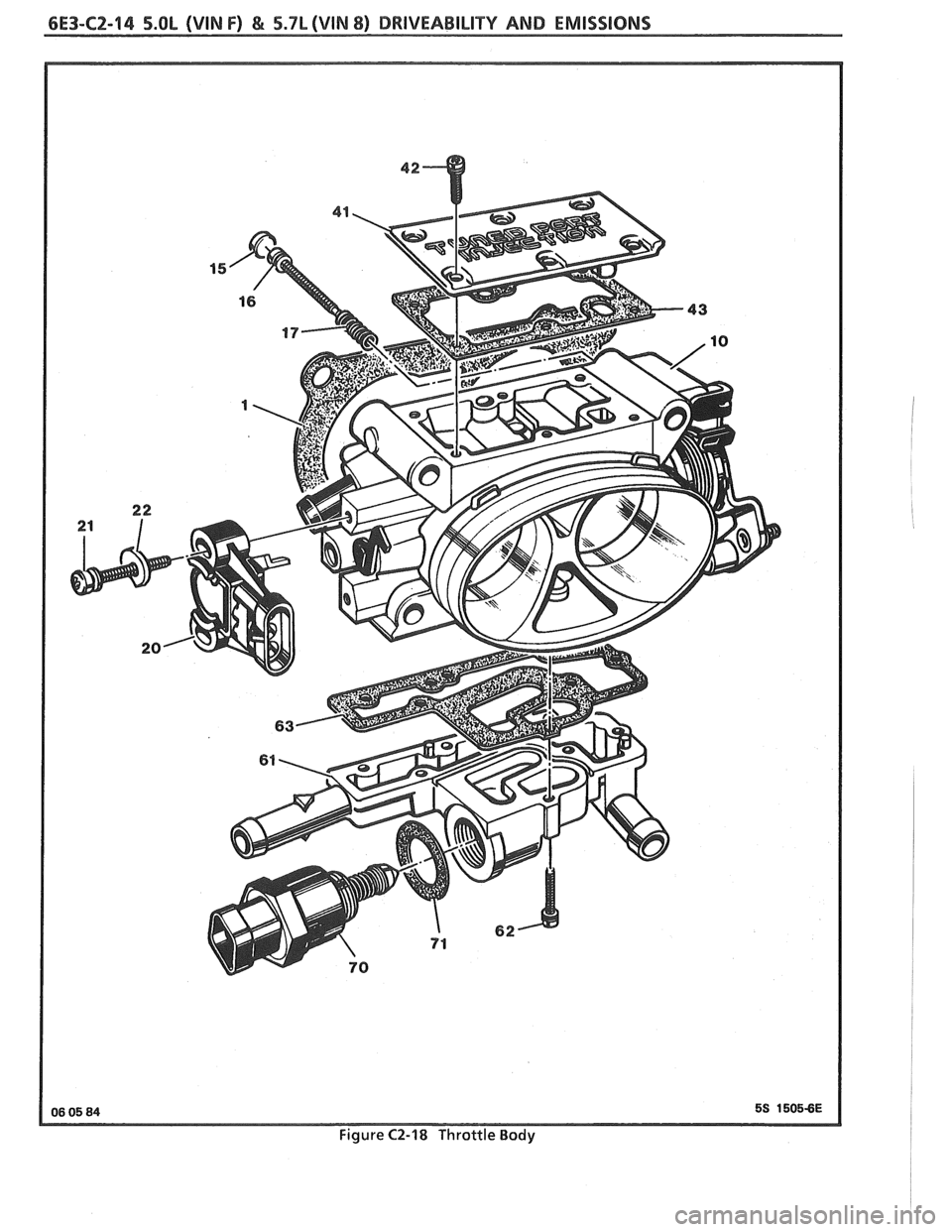
Page 902 of 1825
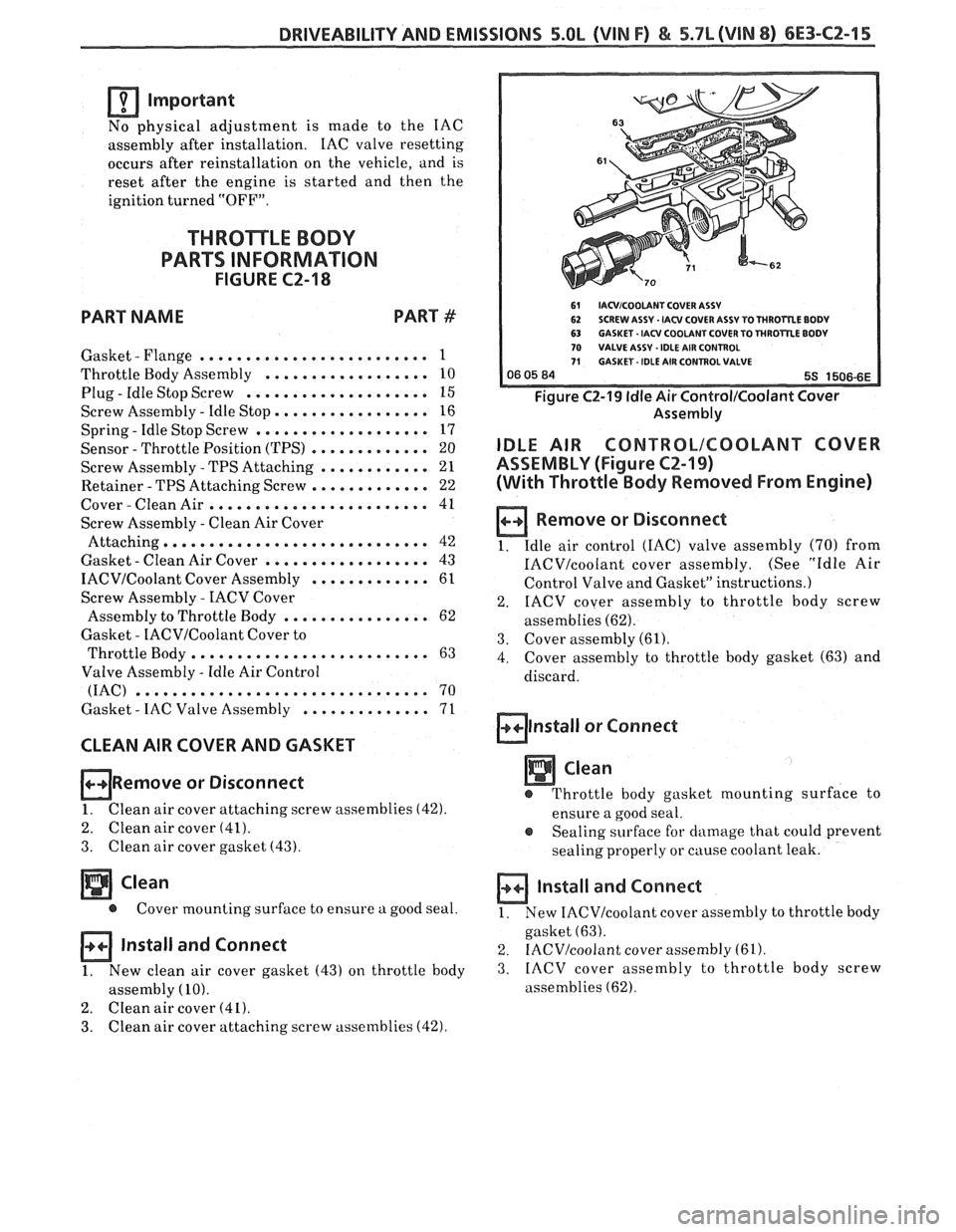
DRIVEABILITY AND EMISSIONS 5.OL (WIN F) & 5.7L (WIN 8) 6E3-C2-15
Important
No physical adjustment is made to the IAC
assembly after installation. IAC
valve resetting
occurs after reinstallation on the vehicle, and is
reset after the engine is started and then the
ignition turned "OFF".
THROTTLE BODY
PARTS INFORMATION
FIGURE CZ-18
PART NAME PART #
. Gasket Flange ......................... 1
Throttle Body Assembly .................. 10
Plug . Idle Stop Screw .................... 15
Screw Assembly - Idle Stop. ................ 16
Spring
- Idle Stop Screw ................... 17
Sensor - Throttle Position (TPS) ............. 20
Screw Assembly
- TPS Attaching ............ 21
Retainer
- TPS Attaching Screw ............. 22
Cover-CleanAir........................ 41
Screw Assembly
- Clean Air Cover
Attaching...
.......................... 42
Gasket
- Clean Air Cover .................. 43
IACVICoolant Cover Assembly ............. 61
Screw Assembly
- IACV Cover
Assembly to Throttle Body
................ 62
Gasket
- IACVICoolant Cover to
Throttle Body..
........................ 63
Valve Assembly
- ldle Air Control
(IAC) ................................ 70
Gasket
- IAC Valve Assembly .............. 71
CLEAN AIR COVER AND GASKET
ORemove or Disconnect
1. Clean
air cover attaching screw assemblies (42)
2. Clean air cover (41).
3. Clean air cover gasket (43).
@ Cover mounting surface to ensure a good seal.
Install and Connect
1. New clean air cover gasket (43) on throttle body
assembly
(10).
2. Clean air cover (41).
3. Clean air cover attaching screw assemblies (42).
61 IACVICOOLANT COVER ASSV 62 SCREW ASSY . IACV COVER ASSY TO THROrRE BODV 63 GASKET. IACV COOLANT COVER TO THROTTLE BODY 70 VALVE ASSV -IDLE AIR CONTROL 71 GASKET - IDLE AIR COHTROLVALVE
Figure C2-19 ldle Air Control/Coolant Cover
Assembly
IDLE AIR CONTRBLICOOLANT COVER
ASSEMBLY (Figure
CZ-19)
(With Throttle Body Removed From Engine)
a Remove or Disconnect
1. Idle
air control (IAC) valve assembly (70) from
IACVIcoolant cover assembly. (See "Idle Air
Control Valve and Gasket" instructions.)
2. IACV
cover assembly to throttle body screw
assemblies
(62).
3. Cover assembly (61).
4. Cover
assembly to throttle body gasket (63) and
discard.
alnstall or Connect
Clean
e Throttle body gasket mounting surface to
ensure a good seal.
e Sealing surface for damage that could prevent
sealing properly or
cause coolant leak.
a Install and Connect
1. New IACVIcoolant cover
assembly to throttle body
gasket
(63).
2. IACV/coolant cover assembly (61).
3. IACV
cover assembly to throttle body screw
assemblies
(62).
Page 903 of 1825
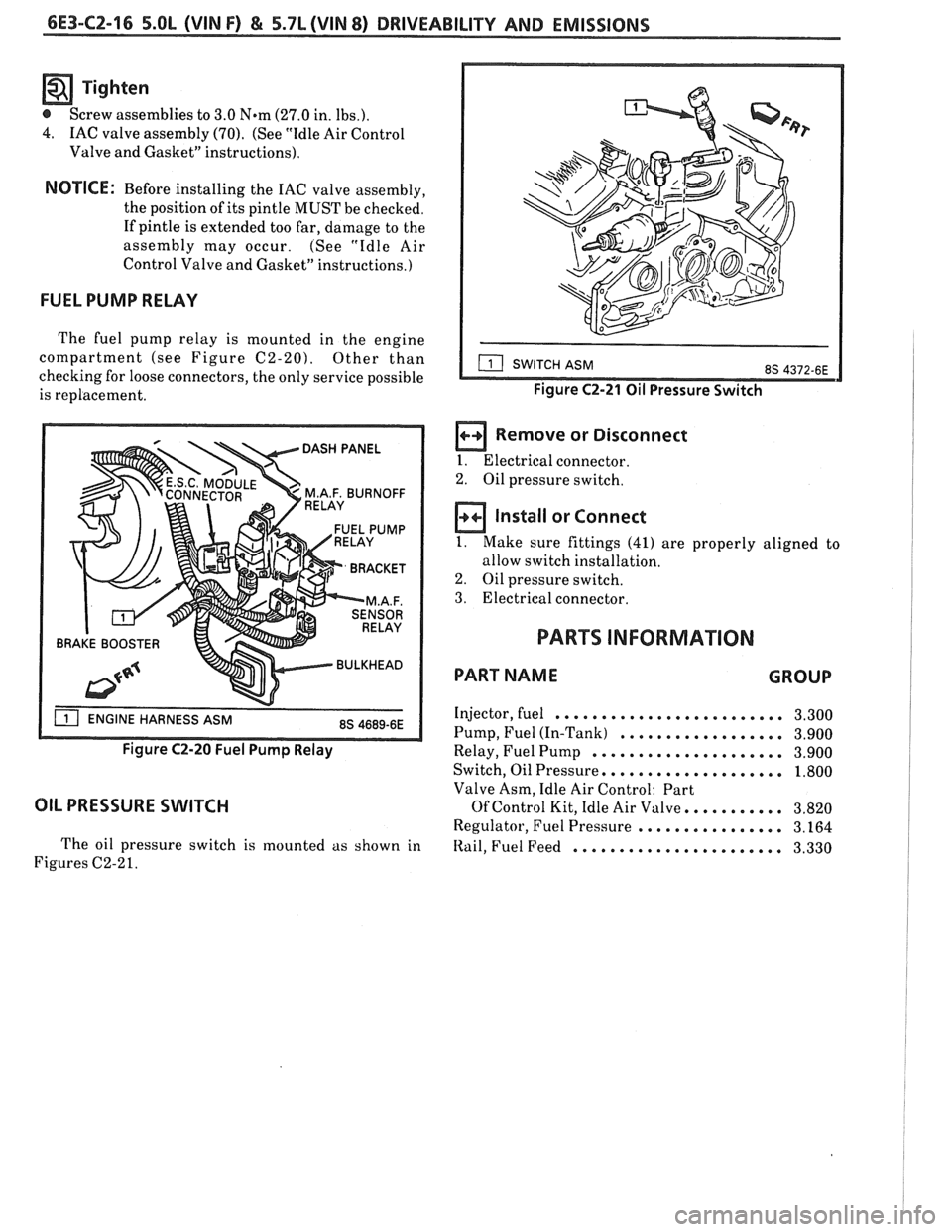
6E3-CZ-16 5.OL (VIN F) & 5.7L(VIN 8) DRIVEABILITY AND EMISSIONS
Tighten
- @ Screw assemblies to 3.0 Nem (27.0 in. lbs.).
4. IAC valve assembly (70). (See "Idle Air Control
Valve and Gasket" instructions).
NOTICE: Before installing the IAC valve assembly,
the position of its pintle
MUST be checked.
If pintle is extended too far, damage to the
assembly may occur. (See
"Idle Air
Control Valve and Gasket" instructions.)
FUEL PUMP RELAY
The fuel pump relay is mounted in the engine
compartment (see Figure
C2-20). Other than
checking for loose connectors, the only service possible
is replacement.
BRAKE BOOSTER
Figure C2-20 Fuel Pump Relay
OIL PRESSURE SWITCH
The oil pressure switch is mounted as shown in
Figures C2-2
1.
Figure C2-21 Oil Pressure Switch
a Remove or Disconnect
I. Electrical connector.
2. Oil pressure switch.
Install or Connect
1. Make sure fittings (41) are properly aligned to
allow switch installation.
2. Oil pressure switch.
3. Electrical connector.
PARTS INFORMATION
PART NAME GROUP
Injector, fuel ......................... 3.300
Pump, Fuel (In-Tank)
.................. 3.900
Relay, Fuel Pump
..................... 3.900
Switch, Oil Pressure,
................... 1.800
Valve Asm, Idle Air Control: Part
Of Control Kit, Idle Air Valve. .......... 3.820
Regulator, Fuel Pressure
................ 3.164
Itail, Fuel Feed ....................... 3.330
Page 904 of 1825
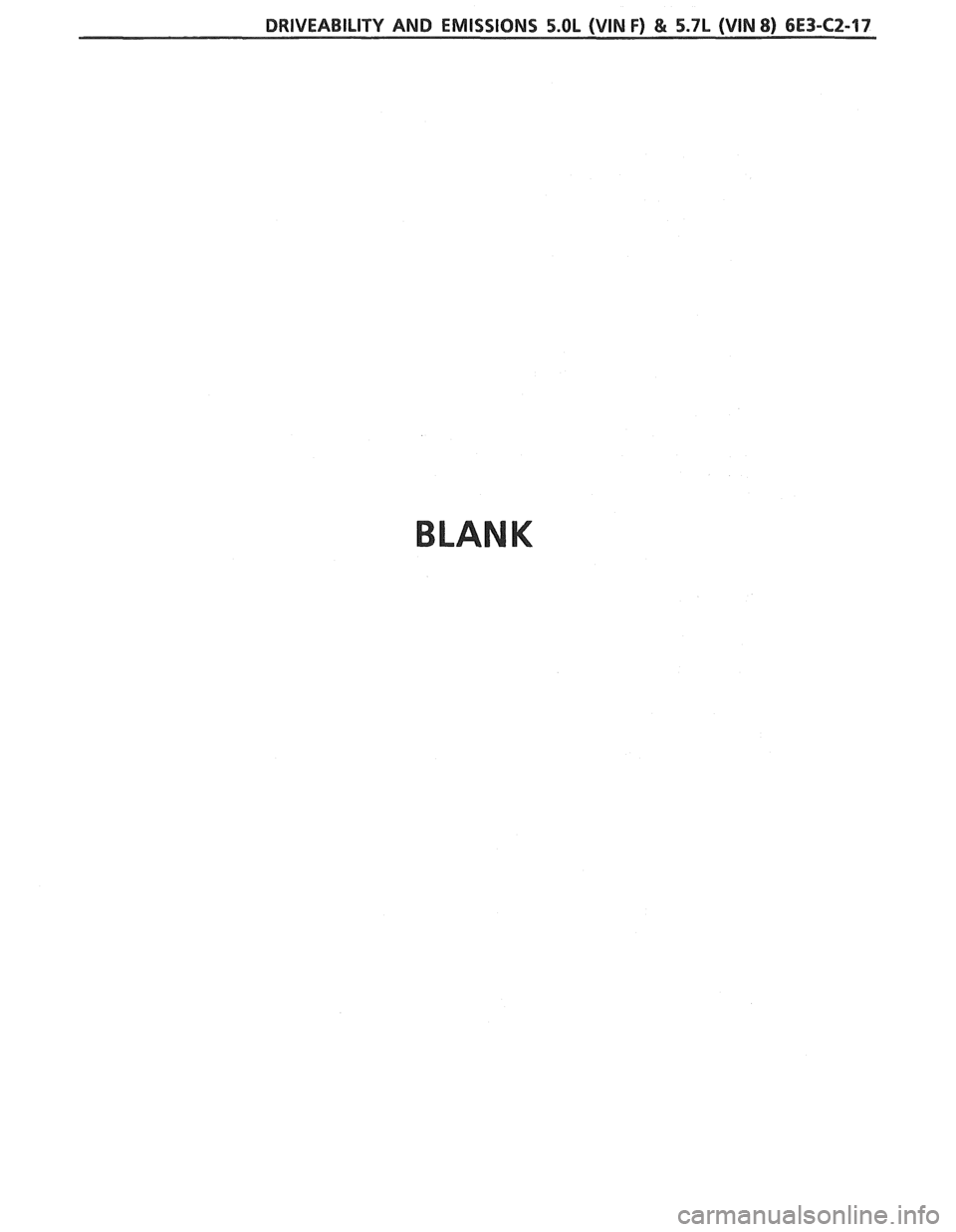
DRIVEABILITY AND EMISSIONS 5.OL (VIN F) & 5.7L (VIN 8) 6E3-CZ-17
BLANK
Page 905 of 1825
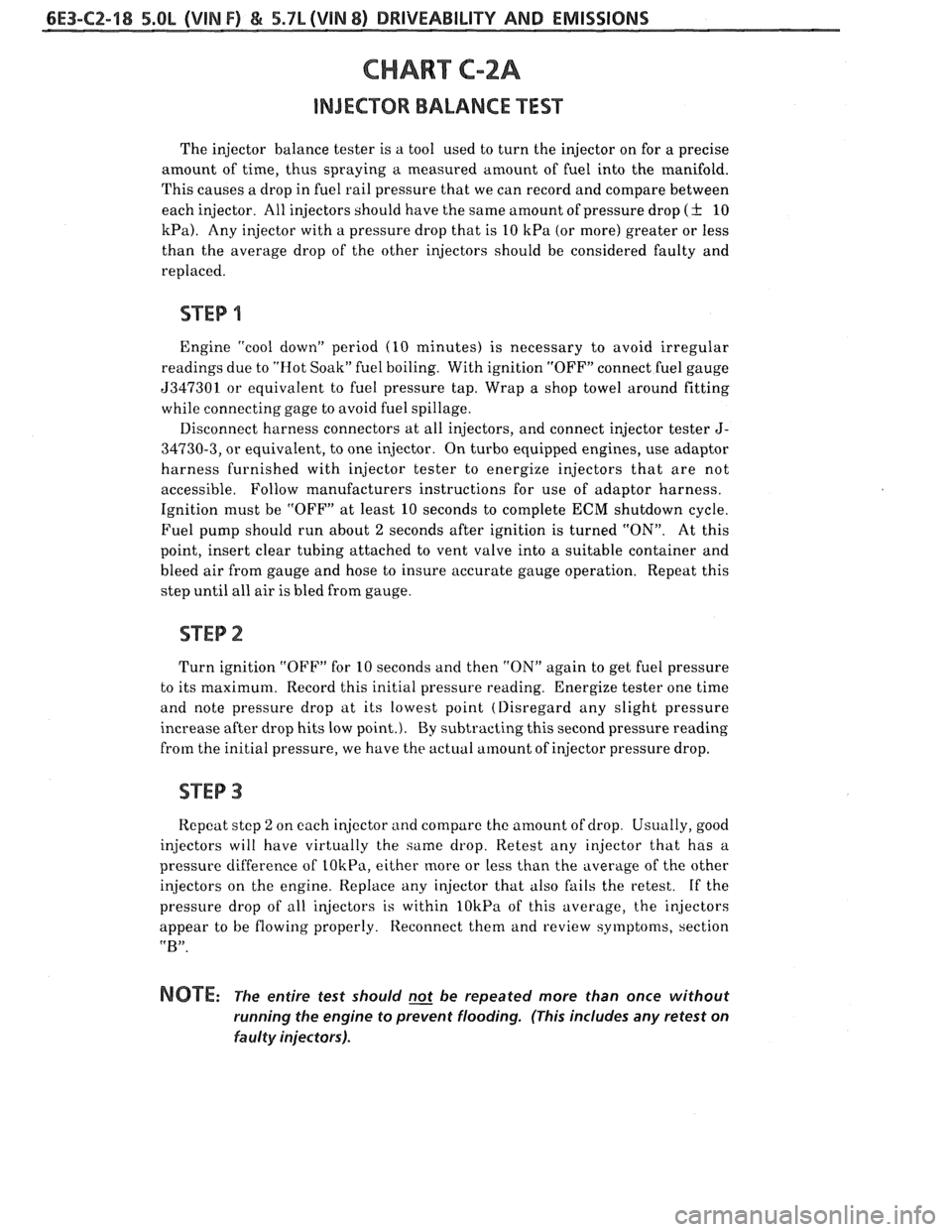
6E3-CZ-18 5.OL (VIN F) & 5.7L(VIN 8) DRIVEABILITY AND EMISSIONS
CHART C-2A
INJECWR BALANCE TEST
The injector balance tester is a tool used to turn the injector on for a precise
amount of time, thus spraying
a measured amount of fuel into the manifold.
This causes a drop in fuel rail pressure that we can record and compare between
each injector. All injectors should have the same amount of pressure drop
( f 10
kPa). Any injector with a pressure drop that is 10 kPa (or more) greater or less
than the average drop of the other injectors should be considered faulty and
replaced.
STEP 1
Engine "cool down" period (10 minutes) is necessary to avoid irregular
readings due to "Hot Soak" fuel boiling. With ignition "OFF" connect fuel gauge
5347301 or equivalent to fuel pressure tap. Wrap a shop towel around fitting
while connecting gage to avoid fuel spillage.
Disconnect harness connectors at all injectors, and connect injector tester
J-
34730-3, or equivalent, to one injector. On turbo equipped engines, use adaptor
harness furnished with injector tester to energize injectors that are not
accessible. Follow manufacturers instructions for use of adaptor harness.
Ignition must be "OFF" at least 10 seconds to complete
ECM shutdown cycle.
Fuel pump should run about
2 seconds after ignition is turned "ON". At this
point, insert clear tubing attached to vent valve into a suitable container and
bleed air from gauge and hose to insure accurate gauge operation. Repeat this
step until all air is bled from gauge.
Turn ignition
"OFF" for 10 seconds and then "ON" again to get fuel pressure
to its maximum. Record this initial pressure reading. Energize tester one time
and note pressure drop at its lowest point (Disregard any slight pressure
increase after drop hits low point.). By subtracting this second pressure reading
from the initial pressure, we have
the actual amount of injector pressure drop.
STEP 3
Rcpcat stcp 2 on each injector and compare the amount of drop. Usually, good
injectors will have virtually the same drop. Retest any injector that has a
pressure difference of
LOkPa, either more or less than the average of the other
injectors on the engine. Replace any injector that also fails the retest.
If the
pressure drop of all injectors is within
lOkPa of this average, the injectors
appear to be flowing properly. Reconnect them and review symptoms, section
"B".
NOTE: The entire test should not be repeated more than once without
running the engine to prevent flooding. (This includes any retest on
faulty injectors).
Page 906 of 1825
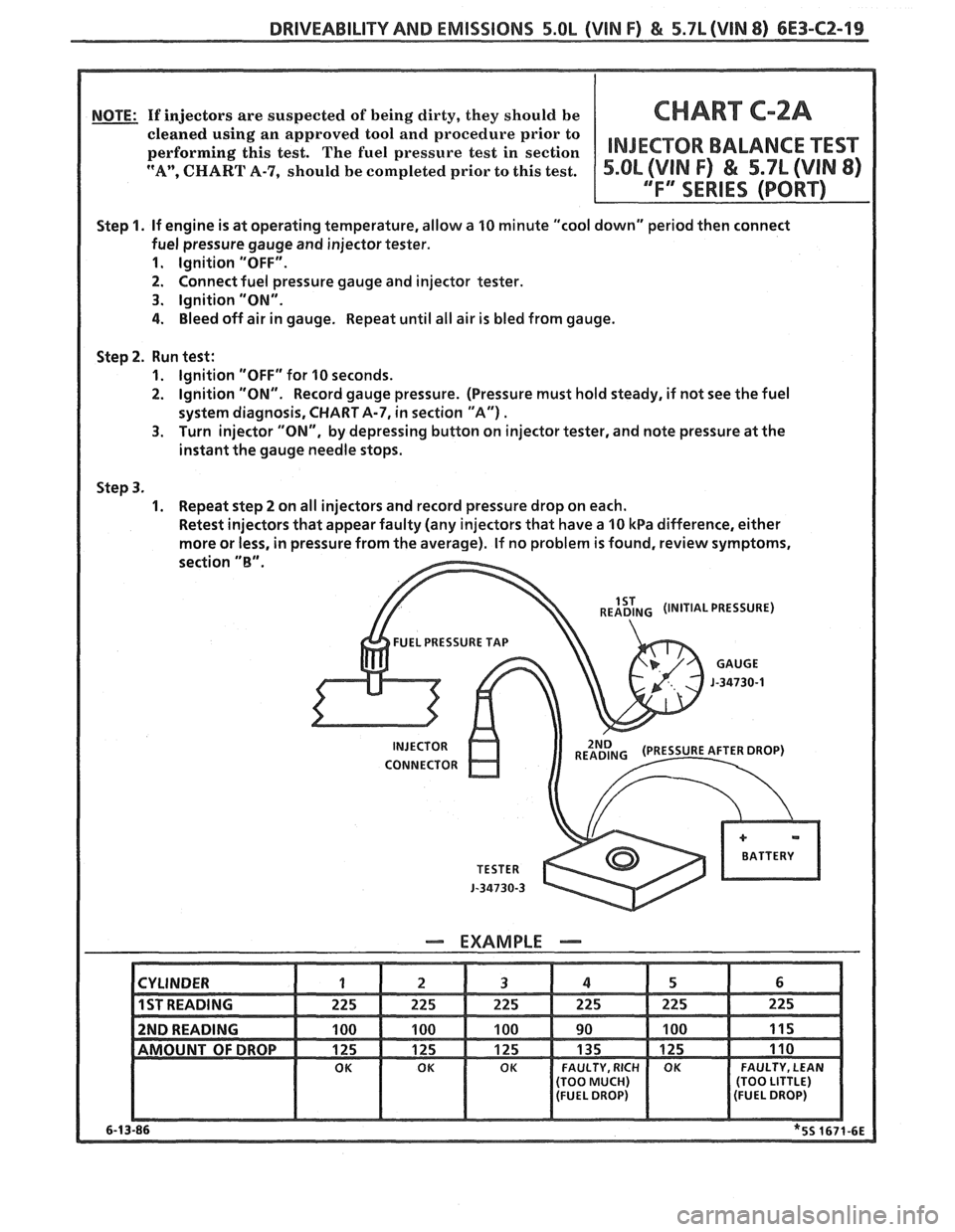
DRIVEABILITY AND EMISSIONS 5.OL (VIN F) & 5.7L (VIN 8) 6E3-CZ-19
NOTE: If injectors are suspected of being dirty, they should be CHART Cm2A
INJEGWOR BALANCE TEST
Step 1. If engine is at operating temperature, allow a 10 minute "cool down" period then connect
fuel pressure gauge and injector tester.
1. Ignition "OFF".
2. Connect fuel pressure gauge and injector tester.
3. Ignition "ON".
4. Bleed off air in gauge. Repeat until all air is bled from gauge.
1. Ignition "OFF" for 10 seconds.
2. Ignition "ON". Record gauge pressure. (Pressure must hold steady, if not see the fuel
system diagnosis, CHART A-7, in section
"A") .
3. Turn injector "ON", by depressing button on injector tester, and note pressure at the
instant the gauge needle stops.
1. Repeat step 2 on all injectors and record pressure drop on each.
Retest injectors that appear faulty (any injectors that have a 10
kPa difference, either
Page 907 of 1825
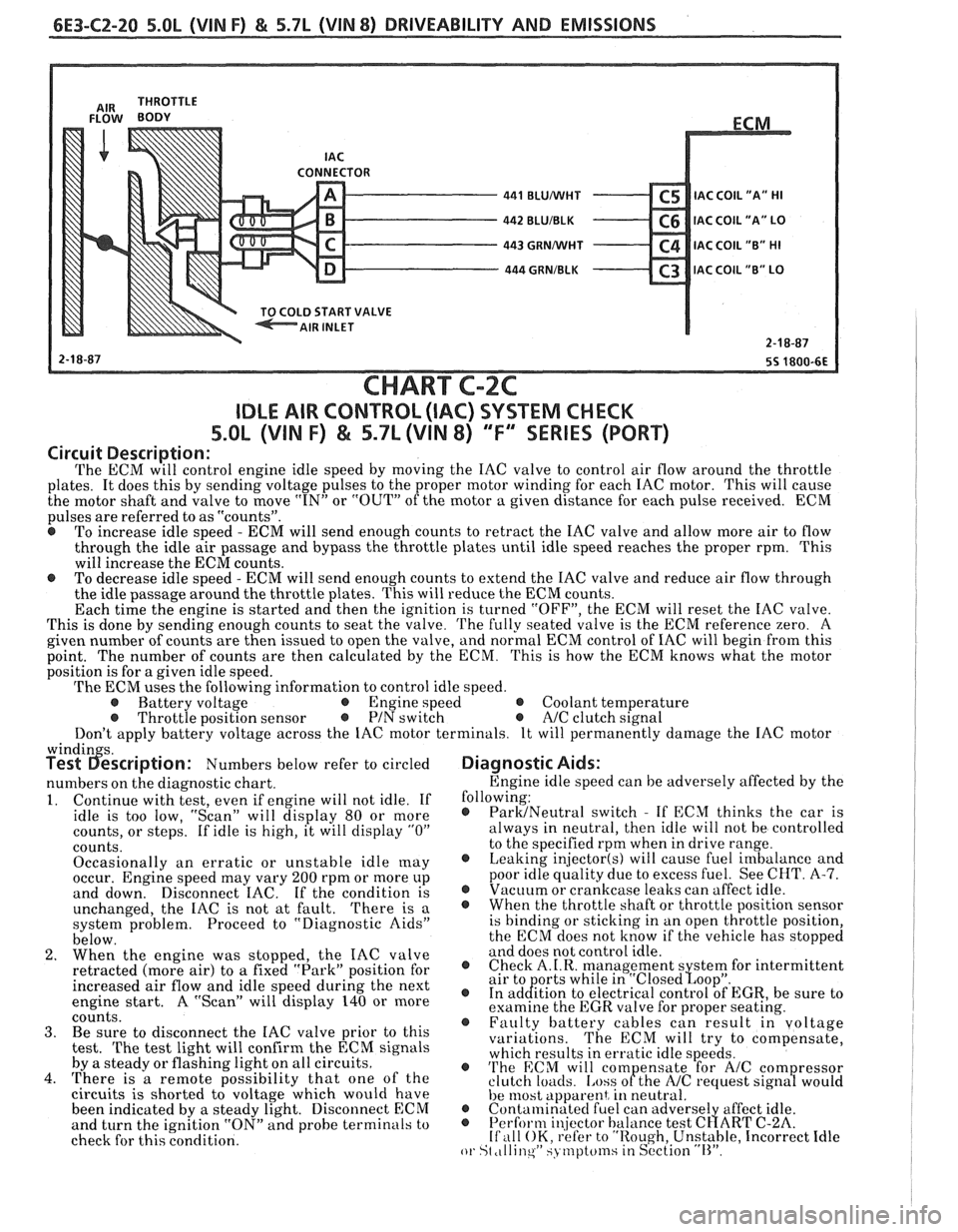
6E3-C2-20 5.0L (VIN F) & 5.7L (WIN 8) DRIVEABILITY AND EMISSIONS
CONNECTOR - 441 BLUMlHT C5 IAC C0lL1'A" HI - 442 BLUIBLK C6 IAC COIL "A" LO - 443 GRNMlHT C4 IAC COIL "B" HI - 444 GRNIBLK C3 lAC COIL "B" LO v
START VALVE
CHART C-2C
IDLE AIR CONTROL (IAC) SYSTEM CHECK
S.OL (VIN F) & 5.7L (VIN 8) "F'" SERIES (PORT)
Circuit Description:
The ECM will control engine idle speed by moving the IAC valve to control air flow around the throttle
plates. It does this by sending voltage pulses to the proper motor winding for each IAC motor. This will cause
the motor shaft and valve to move
"IN" or "OUT" of the motor a given distance for each pulse received. ECM
pulses are referred to as "counts".
@ To increase idle speed - ECM will send enough counts to retract the IAC valve and allow more air to flow
through the idle air passage and bypass the throttle plates until idle speed reaches the proper rpm. This
will increase the ECM counts.
e To decrease idle speed - ECM will send enough counts to extend the IAC valve and reduce air flow through
the idle passage around the throttle plates. This will reduce the ECM counts.
Each time the engine is started and then the ignition is turned "OFF", the ECM will reset the IAC valve.
This is done by sending enough counts to seat the valve.
The fully seated valve is the ECM reference zero. A
given number of counts are then issued to open the valve, and normal ECM control of IAC will begin from this
point. The
number of counts are then calculated by the ECM. This is how the ECM knows what the motor
position is for a given idle speed.
The ECM uses the following information to control idle speed.
@ Battery voltage @ Engine speed @ Coolant temperature @ Throttle position sensor @ PIN switch e A/C clutch signal
Don't apply battery voltage across the IAC motor terminals. It will permanently damage the IAC motor
windin s. Test 6escription: Numbers below refer to circled
numbers on the diagnostic chart.
1. Continue with test, even if engine will not idle. If
idle is too low, "Scan" will display 80 or more
counts, or steps. If idle is high, it will display
"0"
counts.
Occasionally an erratic or unstable idle
[nay occur. Engine speed may vary 200 rpm or more up
and down. Disconnect IAC. If the condition is
unchanged, the IAC is not at fault.
There is a
system problem. Proceed to "Diagnostic Aids"
below.
2. When the engine was stopped, the IAC valve
retracted (more air) to
a fixed "Park" position for
increased air flow and idle speed during the next
engine start. A "Scan" will display 140 or more
coiints. 3. Be sure to disconnect the IAC valve prior to this
test.
The test light will confirm the ECM signals
by a steady or flashing light on all circuits.
4. There is a remote possibility that one of the
circuits is shorted to voltage which would have
been indicated by a steady light. Disconnect ECM
and turn the ignition "ON" and probe terminals to
check for this condition.
Diagnostic Aids:
Engine idle speed can be adversely affected by the
following:
@ ParMNeutral switch - If ECM thinks the car is
always in neutral, then idle will not be controlled
to the specified rpm when in drive range.
@ Leaking injector(s) will cause fuel imbalance and
poor idle quality due to excess fuel. See CHT.
A-7. @ Vacuum or crankcase leaks can affect idle. @ Whenthethrottleshaftorthrottlepositionsensor
is binding or sticking in an open throttle position,
the ECM does not know if the vehicle has stopped
and does not control idle.
@ Check A.I.R. management s stem for intermittent
air to orts while in "~losed~oo~". @ In ad&tion to electrical control of EGR, be sure to
examine the EGR valve for proper seating.
@ Faulty battery cables can result in voltage
variations. The ECM will try to compensate,
which results in erratic idle speeds.
@ 'I'he ECM will com ensate for A/C com ressor
clutch loacls. [.ass ofthe NC request sign8 would
he 11lost apparent, in neutral. @ Contalninatecl fuel can adverse1 affect idle. @ Perform i~!jector balance test C~ART C-2A. If ,111 OK, refer to "Rough, Unstable, Incorrect Idle or St ,tllinqW SJ tnptcfinsiin S~'ction "11''.
Page 908 of 1825
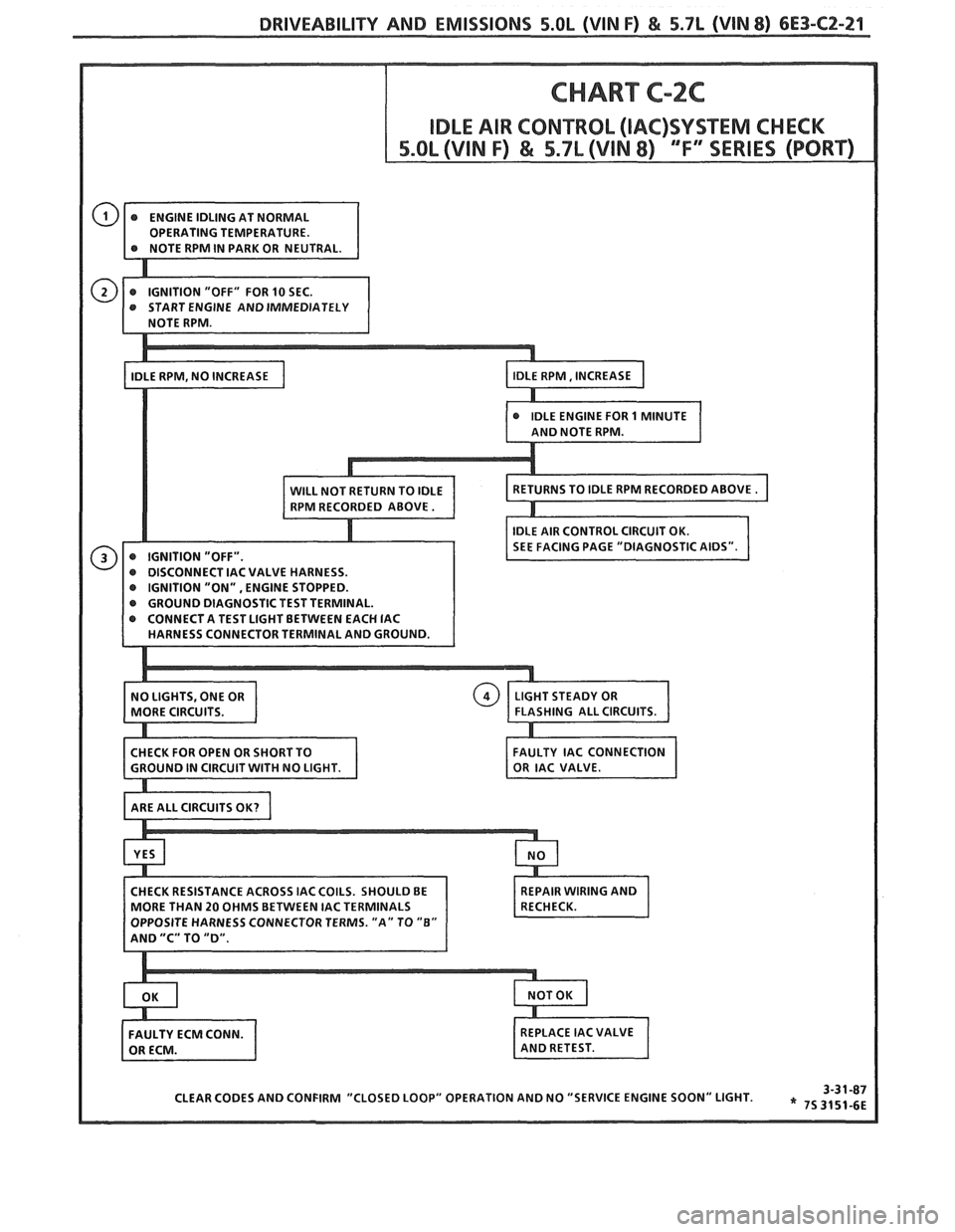
DRIVEABILITY AND EMISSIONS 5.OL (VIN F) & 5.7L (VIN 8) 6E3-C2-21
COILS. SHOULD BE
Page 909 of 1825
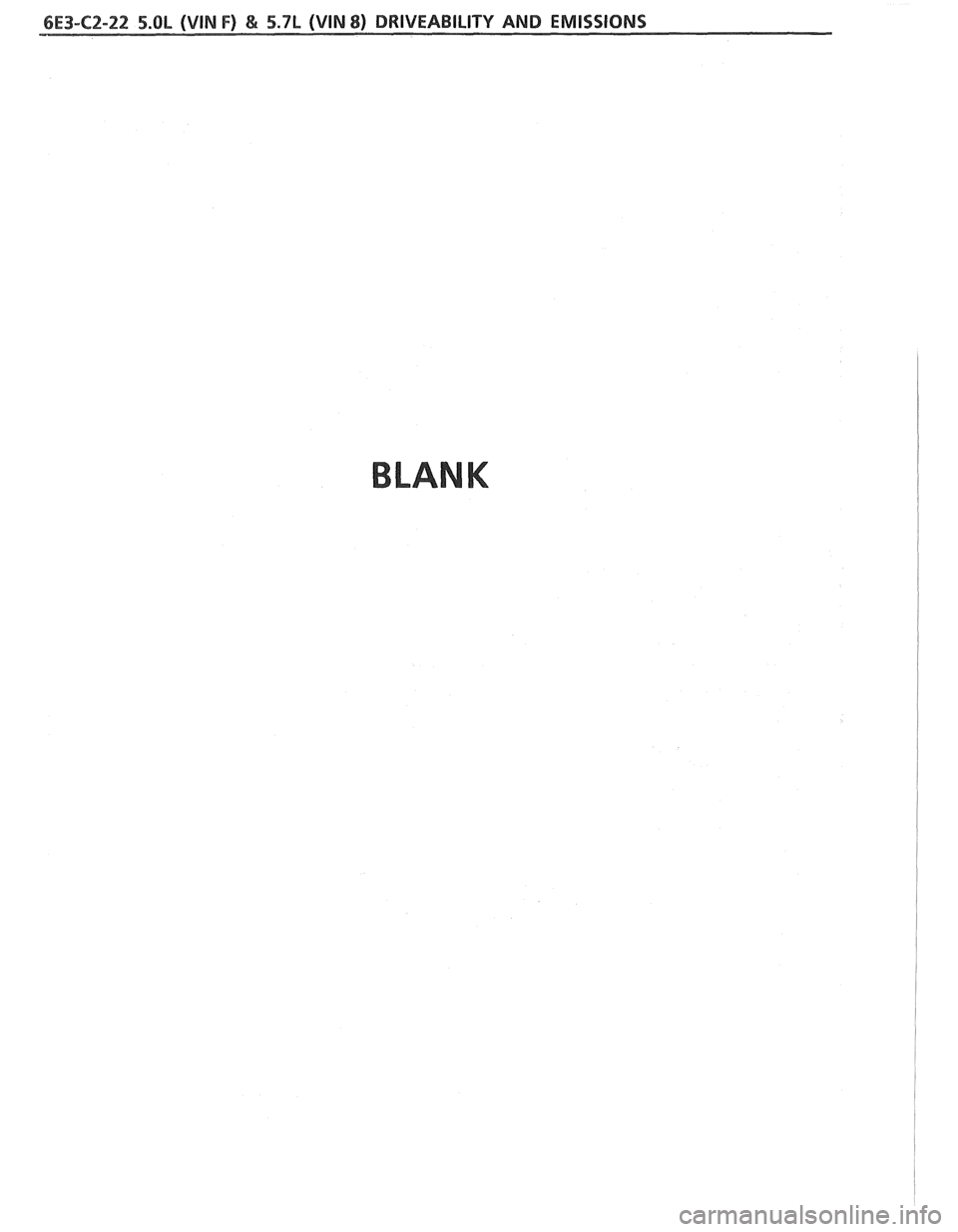
6E3-C2-22 5.BL (VIN F) & 5.7L (VIN 8) DRIVEABILITY AND EMISSIONS
BLANK
Page 910 of 1825
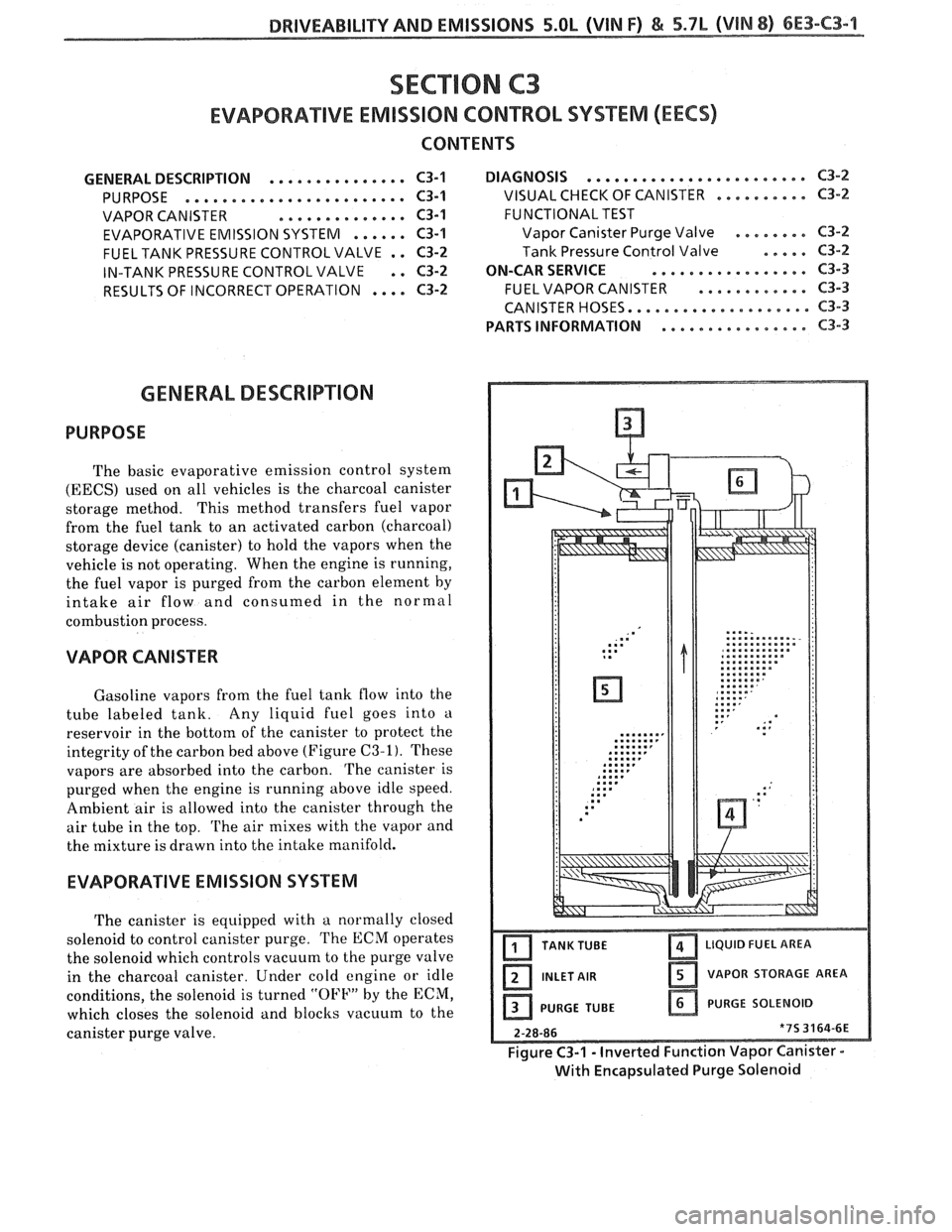
DRIVEABILITYAND EMISSIONS 5.OL (VIN F) & 5.7L (V1N 8) 6E3-C3-9
SECTION C3
EVAPORATIVE EMlSSlON CONTROL SYSTEM (EECS)
CONTENTS
...................... ............... GENERAL DESCRIPTION C3-1 DIAGNOSIS .. C3-2
.......... PURPOSE ........................ C3-1 VISUAL CHECK OF CANISTER C3-2
VAPOR CANISTER .............. C3-1 FUNCTIONAL TEST
EVAPORATIVE EMISSION SYSTEM
...... C3-1 Vapor Canister Purge Valve ........ C3-2
..... FUEL TANK PRESSURE CONTROLVALVE . . C3-2 Tank Pressure Control Valve 63-2
IN-TANK PRESSURE CONTROL VALVE . . C3-2 ON-CAR SERVICE ................. C3-3
RESULTS OF INCORRECT OPERATION .... C3-2 FUEL VAPOR CANISTER ............ C3-3
CANISTERHOSES. ................... C3-3
................ PARTS INFORMATION C3-3
GENERAL DESGRIP"T0N
PURPOSE
The canister is equipped with a normally closed
solenoid to control canister purge.
The ECM operates
the solenoid which controls vacuum to the purge valve
in the charcoal canister. Under cold engine or idle
conditions, the solenoid is turned
"OFF" by the ECM,
which closes the solenoid and blocks vacuum to the
canister purge valve.
The
basic evaporative emission control system
(EECS) used on all vehicles is the charcoal canister
storage method. This method transfers fuel vapor
from the fuel tank to an activated carbon (charcoal)
storage device (canister) to hold the vapors when the
vehicle is not operating. When the engine is running,
the fuel vapor is purged from the carbon element by
intake air flow and consumed in the normal
combustion process.
VAPOR CANISTER
Gasoline vapors from the fuel tank flow into the
tube labeled tank. Any
liquid fuel goes into
a
reservoir in the bottom of the canister to protect the
integrity of the carbon bed above (Figure
C3-1). These
vapors are absorbed into the carbon. The canister is
purged when the engine is running above idle speed.
Ambient air is allowed into the canister through the
air tube in the top.
The air mixes with the vapor and
the mixture is drawn into the intake manifold.
EVAPORATIVE EMISSION SYSTEM
TANK TUBE
INLET AIR
I PURGE TUBE
fl LIQUID FUEL AREA
a VAPOR STORAGE AREA
a PURGE SOLENOID
Fiqure C3-1 - Inverted Function Vapor Canister - - With Encapsulated Purge Solenoid